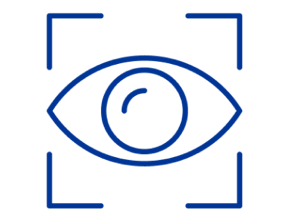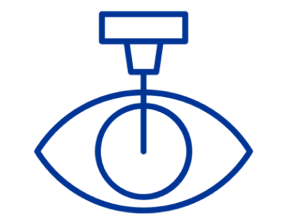Discover laser eye
surgery options
Proven over 30 years and used for more than 40 million procedures worldwide, LASIK has helped millions of people see more clearly.1,2 Talk to your eye doctor about laser eye surgery, and get the information you need to understand your options.
Discover laser eye surgery options
Proven over 30 years and used for more than 40 million procedures worldwide, LASIK has helped millions of people see more clearly.1,2 Talk to your eye doctor about laser eye surgery, and get the information you need to understand your options.
Types of Laser Eye Surgery
Standard LASIK, PRK and advanced technology like wavelight plus and Contoura Vision, all use laser energy to reshape the cornea of your eye,3 but PRK uses a different surgical technique to access that part of your eye.4 Learn the differences between advanced personalized, standard and flap-free procedures.

Personalized LASIK
Advanced LASIK procedures use advanced technology to personalize treatment based on the unique characteristics of your eyes. Unlike standard LASIK, which follows a general prescription model, customized options like wavelight plus and Contoura Vision take detailed measurements of your eye to help guide your surgical plan. This approach is designed to enhance the precision of the procedure and the overall quality of your visual outcome.7-11

Standard LASIK
This is the original form of LASIK, based on your glasses or contact lens prescription. It corrects vision effectively for many patients but doesn’t account for higher-order aberrations—vision imperfections that are more complex than common issues like nearsightedness, farsightedness, or astigmatism—or corneal irregularities.5

PRK laser eye surgery
PRK (Photorefractive Keratectomy) is a type of laser vision correction that reshapes the surface of the eye. Unlike some other procedures, it does not involve creating a corneal flap.3
This approach may be recommended based on factors such as corneal thickness or playing contact sports.6 Alcon’s wavelight laser system is one of the technologies that may be used during PRK procedures.
Not All Laser Eye Surgeries Are the Same—Find the Right Fit for You
Compare Alcon's Laser Vision Correction Options
Understand the Differences In Laser Eye Surgery

*In a real-world private practice setting, 200 patients (400 eyes).
†In a prospective study of 130 eyes.
Discover wavelight plus — the first fully personalized LASIK procedure
Wavelight plus measures your entire optical system.7-9 Over 100,000 data points are captured to create a 3D model of your eye, your “Digital Twin”,7–9,12,18 which enables your LASIK treatment to be designed and tested virtually before being applied to your eyes.7,8,12 The result? Sharp vision tailored just for you.7,15 Learn more how this next-generation laser treatment could be right for you.

Contoura Vision
A form of LASIK surgery, CONTOURA Vision captures up to 22,000 data points on each individual eye to create a map that’s completely unique to your eyes and addresses surface irregularities.19,20

Frequently Asked Questions
Choosing the right vision correction procedure depends on your individual eye health, lifestyle, and vision goals. During a thorough eye exam, your doctor will evaluate the shape and thickness of your cornea, your prescription, and other important factors. They will then recommend the procedure best suited to your eyes—whether it’s LASIK, PRK, or another option.
Yes, patients with thin corneas or dry eyes may still be eligible for laser vision correction, but LASIK may not always be the best option. Procedures like PRK (Photorefractive Keratectomy) are often recommended because they do not involve creating a corneal flap, which can preserve more corneal tissue and reduce the risk of flap-related complications.21
In many cases, yes. LASIK has been approved by the FDA to treat myopia, and astigmatism, including higher prescriptions within certain limits.22 There are several types of LASIK, and the most advanced ones, such as wavelight plus and Contoura Vision, are highly customized to the unique shape of your eyes.23 Wavelight plus uses advanced technology to create a unique 3D profile of your eye, making sure that your treatment plan is personalized accordingly.9,12 Wavelight Contoura uses advanced LASIK technology and a proprietary measurement system to create a unique map of the eye’s surface, allowing doctors to see all the unique peaks and troughs of the cornea.10,14 However, extremely high prescriptions or irregular corneas may require alternative treatments like PRK or implantable lenses.24,25
Most patients achieve better vision after LASIK or PRK, which is typically sufficient for most daily activities without glasses or contact lenses. However, some people may still need glasses for night driving or reading, especially as they get older and develop presbyopia—a normal age-related loss of near focusing ability.22,26 Check with your doctor for the latest LASIK technologies like wavelight plus, which allows >98% of patients to achieve 20/20 vision or better,7 and addresses your individual optical imperfections to enhance your quality of vision.7,27
Still have questions?
Talk to an eye surgeon to explore which laser eye surgery is right for you.
References:
1. Shapiro D. LASIK Invented 30 Years Ago, FDA Approved 20 Years Ago. Published October 31, 2019. Accessed July 24, 2024. https://shapirolaser.com/lasik-invented-30-years-ago-fda-approved-20-years-ago/.
2. Stodola E. LASIK Worldwide. Published April 2016. Accessed July 24, 2024. https://web.archive.org/web/20180612162458/https://www.eyeworld.org/article-lasik-worldwide.
3. Bastawrous A, Silvester A, Batterbury M. Laser refractive eye surgery. BMJ. 2011;342:d2345.
4. Gaeckle HC. Early clinical outcomes and comparison between trans-PRK and PRK, regarding refractive outcome, wound healing, pain intensity and visual recovery time in a real-world setup. BMC Ophthalmol. 2021;21:181.
5. Mayo Clinic. LASIK Eye Surgery. Accessed May 3, 2022. Accessed from: https://www.mayoclinic. org/tests-procedures/lasik-eye-surgery/about/pac-20384774.
6. Ambrósio R, Wilson SE. LASIK vs LASEK vs PRK: Advantages and indications. Semin Ophthalmol. 2003;18(1):2–10.
7. Kanellopoulos AJ, Maus M, Bala C, Hamilton C, Lemonis S, Jockovich ME, Khoramnia R. International multicenter, myopic and myopic astigmatism Femto LASIK, customized by automated Ray-Tracing Ablation Profile Calculation: A postmarket study. Clin Ophthalmol. 2024;18:525–536.
8. Mrochen M, Bueeler M, Donitzky C, Seiler T. Optical ray tracing for the calculation of optimized corneal ablation profiles in refractive treatment planning. J Refract Surg. 2008;24(4):S446–S451.
9. Wavelight InnovEyes™ Sightmap Diagnostic Device User Manual. 2018.
10. Ozulken F, Yuksel E Tekin K, et al. Comparison of wavefront-optimized ablation and topography-guided Contoura ablation with LYRA protocol in LASIK. J Refract Surg. 2019;35(4):222–229.
11. Alcon Data on File, 2021. [REF-18191].
12. Schumacher S, Seiler T, Cummings A, Maus M, Mrochen M. Optical ray tracing-guided laser in situ keratomileusis for moderate to high myopic astigmatism. J Cataract Refract Surg. 2012;38(1):28-34.
13. He G, Bala C. Ray-tracing-guided myopic LASIK: real-world clinical outcomes. J Cataract Refract Surg. 2023;49(11):1140-1146.
14. Brunson P, Mann PM II, Mann PM, Potvin R. Comparison of refractive and visual acuity results after Contoura® Vision topography-guided LASIK planned with the Phorcides Analytic Engine to results after wavefront-optimized LASIK in eyes with oblique astigmatism. PLoS ONE. 2022;17(12):e0279357.
15. Stulting RD, Lobanoff M, Mann PM 2nd, Wexler S, Stonecipher K, Potvin R. Clinical and refractive outcomes after topography-guided refractive surgery planned using Phorcides surgery planning software. J Cataract Refract Surg. 2022;48(9):1010–1015.
16. Stonecipher KG, Kezirian GM. Wavefront-Optimized Versus Wavefront-Guided LASIK for Myopic Astigmatism With the ALLEGRETTO WAVE: Three-Month Results of a Prospective FDA Trial. J Refract Surg. 2008;24(4):S424-S430. doi:10.3928/1081597X-20080401-20.
17. Sandoval HP, et al. Modern Laser In Situ Keratomileusis Outcomes. J Cataract Refract Surg. 2016;42(8):1224-1234. doi:10.1016/j.jcrs.2016.07.012.
18. Penna RR, de Sanctis U, Catalano M, Brusasco L, Grignolo FM. Placido disk-based topography versus high-resolution rotating Scheimpflug camera for corneal power measurements in keratoconic and post-LASIK eyes: reliability and agreement. Int J Ophthalmol. 2017;10(3):453-460. Published 2017 Mar 18.
19. Wavelight ALLEGRO Topolyzer VARIO User Manual.
20. Lobanoff M, Stonecipher K, Tooma T, Wexler S, Potvin R. Clinical outcomes after topography-guided LASIK: comparing results based on a new topography analysis algorithm with those based on manifest refraction. J Cataract Refract Surg. 2020;46(6):814–819.
21. PRK (Photorefractive Keratectomy): Treatment, Side Effects & Recovery. Cleveland Clinic. Updated January 18, 2023. Accessed May 24, 2023.
22. Mayo Clinic. LASIK Eye Surgery. Accessed May 3, 2022. Accessed from: https://www.mayoclinic.org/tests-procedures/lasik-eye-surgery/about/pac-20384774.
23. EX500 Excimer Laser User Manual.
24. Gunn DJ, Cox RA. StreamLight Single-Step Transepithelial Photorefractive Keratectomy (PRK) for Myopia and Myopic Astigmatism. J Ophthalmol. 2024;2024:5597457.
25. Refractive Surgery Council. Implantable Lenses at a Glance. 2023. Accessed April 26, 2023. https://americanrefractivesurgerycouncil.org/implantable-lenses/.
26. American Academy of Ophthalmology. LASIK — Laser Eye Surgery. August 9, 2024. Accessed September 5, 2025. https://www.aao.org/eye-health/treatments/lasik.
27. Khoramnia R, Naujokaitis T, Blöck L, et al. Prospective intraindividual comparison of automated customized ray-tracing-guided vs wavefront-optimized laser in situ keratomileusis. Ophthalmology. Published online June 5, 2025.
Please refer to relevant product directions for use for complete list of indications, contraindications, and warnings. Consult your doctor on relevant safety information about the treatment.
